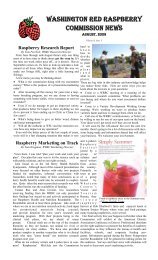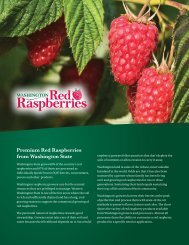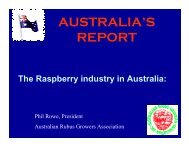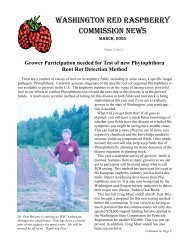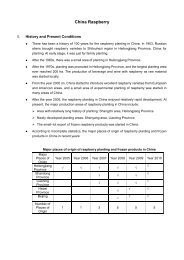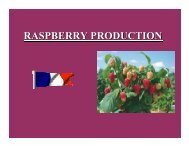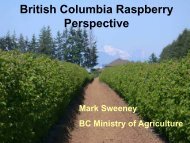2012 - Washington Red Raspberry Commission
2012 - Washington Red Raspberry Commission
2012 - Washington Red Raspberry Commission
You also want an ePaper? Increase the reach of your titles
YUMPU automatically turns print PDFs into web optimized ePapers that Google loves.
growers in the Lynden area that have report early season levels of two spotted spider mites<br />
(TSSM), Tetranychus urticae and yellow spider mite (YSM), Eotetranychus carpini borealis<br />
over the past two seasons. With grower/fieldman cooperation, we will take samples at<br />
appropriate REIs for every insecticide/miticide applied for mite control and during the harvest<br />
period for SWD management. Motile life stage counts will be made by randomly collecting 25<br />
terminal leaflets from foliage at chest height from both sides of the row and brushing them with a<br />
mite-brushing machine onto glass plates coated with a thin film of dishing washing detergent on<br />
the same day. Five plots, 10x30 feet will be randomly placed in each red raspberry field. Counts<br />
will be made with a 10X stereomicroscope. Motile stages of phytoseiid predators (e.g.,<br />
Neoseiulus fallacis) will also be sampled from the same glass plate. Small plot trials will be<br />
conducted at the WSU NWREC ‘Meeker’ field to evaluate field efficacy of experimental<br />
acaricides for submission to IR-4 for residue trials.<br />
MRL guidelines<br />
Countries have responded to increasing global trade and heightened food safety concerns, by<br />
setting maximum residue levels (MRL) on agricultural imports, often stricter than our own.<br />
Spotted wing drosophila has disrupted red raspberry production in <strong>Washington</strong> State. The<br />
industry has responded to its first direct pest by setting a zero tolerance toward larvae<br />
contaminating the fruit, resulting in growers applying up to 10 chemical treatments at 5-7 day<br />
intervals until the end of the harvest season. Spotted wing drosophila has nearly replaced our<br />
decades’ long emphasis on promoting IPM, with calendar sprays. Growers have not only<br />
increased insecticide use to control of SWD but also often severely restricted their choice of<br />
effective chemistries in order to meet their target export market’s approved list. IRM<br />
management strategies have increasingly been replaced with multiple back-to-back applications<br />
of the same mode of action chemistries, such as Mustang Max ® . While Mustang Max like other<br />
pyrethroids provides excellent control, resistance development is eminent.<br />
We will provide <strong>Washington</strong> red raspberry growers with examples of insecticide usage plans (i.e.<br />
rates and number of applications/season) from the five major export countries. Following these<br />
guidelines will assist our growers to meet their target MRLs. These guidelines fluctuate<br />
periodically requiring annual reevaluation to remain current. We propose to interface with a<br />
similar database already managed by Dr. Michael J. Willett, Technical Issues Manager for the<br />
Northwest Horticultural Council. With this information, growers will be more confident to<br />
increase their mode of action chemistries fending off resistance.<br />
Anticipated benefits and information transfer: This study will provide a list of registered<br />
insecticides, including new MOA chemistries, to manage SWD in red raspberry in <strong>Washington</strong><br />
with emphasis on IRM, implications of foreign market MRLs and new IR-4 residue tolerance<br />
projects. New knowledge about the timing of chemical applications, phenology of red raspberry<br />
ripening characteristics, pest emergence such as early season spider mites, SWD generations,<br />
population dynamics and ovarian morphology will provide directions for identifying optimum<br />
window(s) to effectively manage SWD. Hopefully we can provide growers with easily<br />
accessible MRLs for their export countries of choice. Extension education will provide this<br />
information to all interested growers through meetings, internet resources and websites.<br />
102



